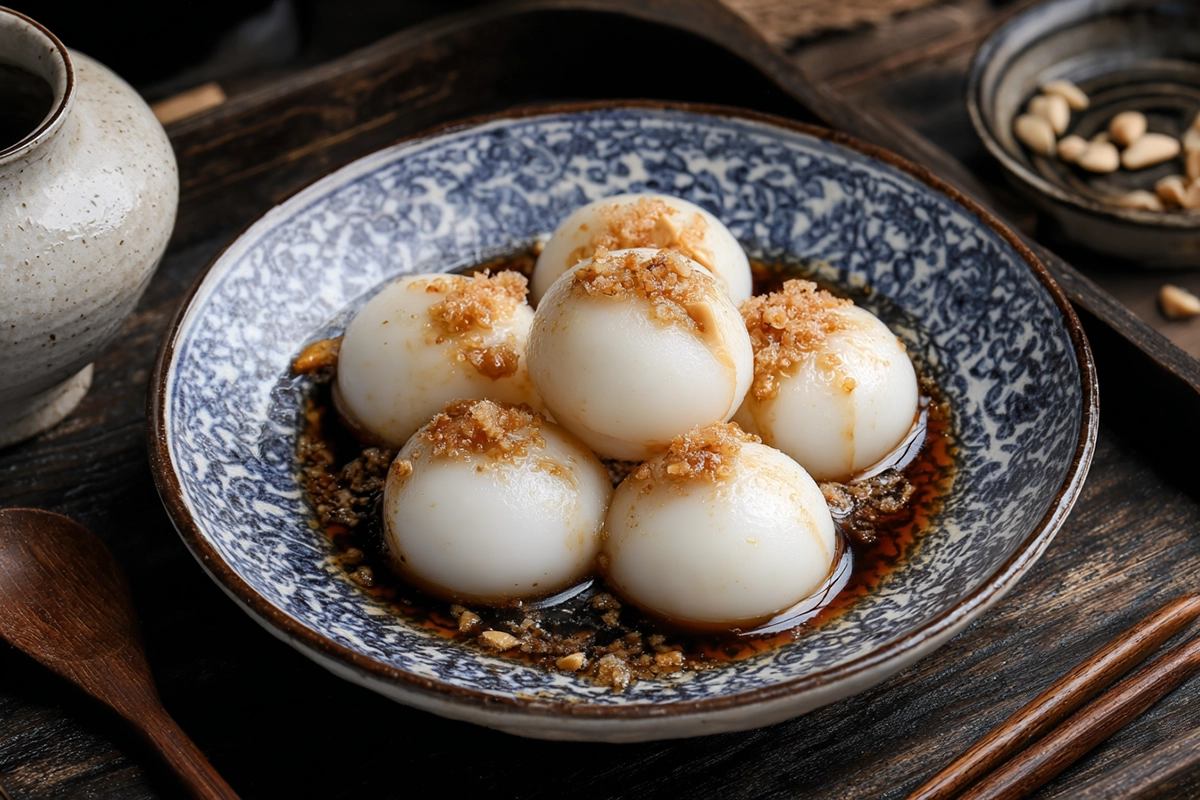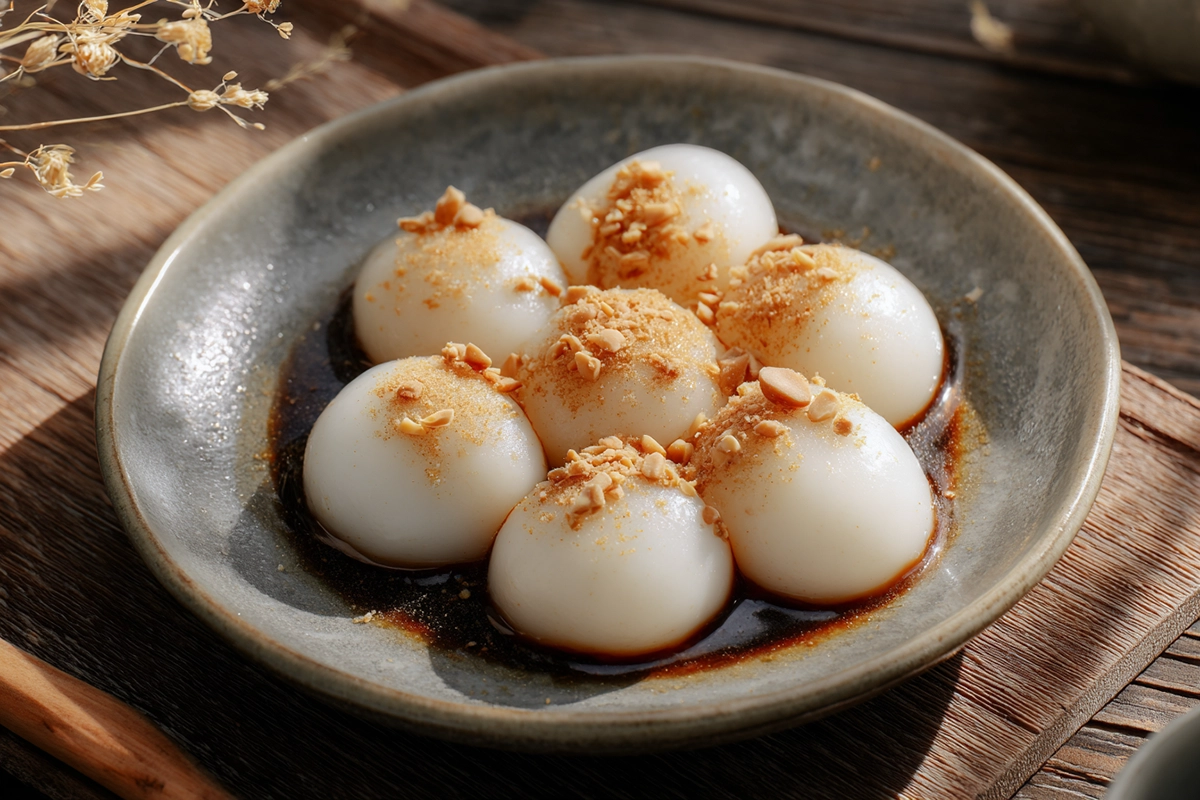If you’ve ever strolled through a Japanese festival or peeked into a dessert shop in Tokyo, chances are you’ve spotted these adorable little white dumplings. Known as Shiratama Dango, these bite-sized mochi balls are a traditional Japanese rice dumpling made from shiratamako (glutinous rice flour).
They’re soft, chewy, and versatile—kind of like the marshmallows of Japanese sweets. You can pair them with red bean paste, dust them with nutty kinako, drizzle them with kuromitsu syrup, or even toss them on top of a parfait or ice cream sundae.
The best part? Making them at home is surprisingly simple. With just two ingredients—shiratamako and water—you’ll have a batch of perfectly chewy dumplings in under 20 minutes. It’s a great recipe to try with kids, a fun weekend project, or a way to bring a little Japanese café magic into your kitchen.
So, if you’ve been curious about trying a shiratamako recipe or just want a sweet rice flour dessert that’s both playful and satisfying, this one’s for you.
Why You’ll Love Shiratama Dango
-
Made with just two ingredients—couldn’t be simpler.
-
Soft, chewy mochi balls that pair beautifully with sweet or fruity toppings.
-
A Japanese rice dumpling tradition you can recreate at home.
-
Fun for kids (rolling the dough is basically edible Play-Doh!).
-
Naturally gluten-free and light enough to enjoy as an afternoon snack or after-dinner treat.
Ingredients
-
100 g (3.5 oz) shiratamako (glutinous rice flour)
-
90–100 ml (6–7 tbsp) water (adjust for texture)
Step-by-Step Instructions
-
Mix the Dough: Place shiratamako in a mixing bowl. Slowly add water, a tablespoon at a time, mixing with your hands until a smooth, pliable dough forms. The texture should be soft but not sticky.
-
Shape the Balls: Divide the dough into 10–12 equal pieces. Roll each one into a smooth, round ball.
-
Cook the Dumplings: Bring a pot of water to a boil. Add the mochi balls and cook until they float to the surface (2–3 minutes). Let them cook for 1–2 minutes more to set.
-
Cool Quickly: Remove with a slotted spoon and transfer to a bowl of ice water. Let them sit for 1–2 minutes to firm up.
-
Serve and Enjoy: Drain well and serve with your favorite toppings like kuromitsu syrup, kinako, red bean paste, or fresh fruit.
Cooking Tips for the Perfect Mochi Balls
-
Check the texture: If the dough feels crumbly, add a tiny splash more water. If it’s sticky, sprinkle in a touch more flour.
-
Size matters: Try to keep the balls uniform in size so they cook evenly.
-
Don’t overcook: Once they float and cook for another minute or two, they’re done. Overcooking makes them too soft.
-
Ice bath is key: Cooling them in ice water keeps the chewy texture just right.
-
Make it colorful: Add matcha powder, black sesame, or food coloring to the dough for a fun twist.
A Personal Note from My Kitchen
I remember my first taste of Shiratama Dango during a summer festival in Japan. The vendor handed me a skewer of chewy dumplings drizzled with dark, molasses-like kuromitsu. I took one bite and thought, “Oh, this is the kind of dessert that doesn’t just satisfy—you remember it.”
Fast forward a few years, and now making these little rice dumplings at home has become one of my favorite ways to bring a piece of Japan into my everyday kitchen. My kids love rolling the dough (though some of their “balls” come out more potato-shaped than round), and topping them with ice cream always turns snack time into a celebration.
It’s proof that sometimes the simplest recipes are the most magical.
What to Serve with Shiratama Dango
These dumplings are a blank canvas for all kinds of toppings and pairings:
-
Traditional style: Serve with kuromitsu (brown sugar syrup) and kinako (roasted soybean flour).
-
Fruity: Add strawberries, mango, or peaches for a refreshing twist.
-
Café-style: Top with vanilla ice cream, matcha syrup, and a sprinkle of kinako.
-
Hearty: Pair with sweet red bean paste (anko) for an authentic Japanese treat.
-
Parfait topper: Drop a few in a matcha parfait or alongside jelly desserts for texture.
How to Store Leftovers
-
Room temperature: Best eaten fresh, but they can sit at room temp for a few hours if covered.
-
Refrigerator: Store in water in an airtight container for up to 1–2 days. They’ll firm up, but you can soften them by briefly soaking in warm water.
-
Freezer: You can freeze them after boiling and cooling. Store in a single layer on a tray first, then transfer to a bag. Reheat in boiling water for a few minutes before serving.
FAQs About Shiratama Dango
What’s the difference between shiratamako and mochiko?
Both are glutinous rice flours, but shiratamako is more refined and gives a smoother, chewier texture—perfect for dumplings.
Can I make these with mochiko instead?
Yes, but the texture will be slightly denser. Shiratamako is the traditional choice.
Do I have to use an ice bath?
Yes! It’s the secret to that perfect chewy texture.
Are Shiratama Dango sweet on their own?
No, they’re neutral. The sweetness comes from the toppings you pair them with.
Can I make flavored mochi balls?
Absolutely—try matcha powder, cocoa powder, or even food coloring for a fun twist.
A Sweet Rice Flour Dessert Worth Trying
There’s something delightfully nostalgic about Shiratama Dango—they’re simple, chewy, and endlessly customizable. Whether you enjoy them in the traditional Japanese way with kinako and kuromitsu or dress them up with fruit and ice cream, these mochi balls are guaranteed to make any day feel a little more special.
So next time you’re craving a light yet satisfying sweet rice flour dessert, skip the packaged sweets and roll up a batch of these charming dumplings. Your taste buds (and your inner child) will thank you.
Discover more delicious recipes by following me on Facebook and Pinterest.
Print
Shiratama Dango
- Total Time: 15 minutes
- Yield: 10–12 dumplings 1x
- Diet: Gluten Free
Description
Shiratama Dango are soft, chewy Japanese mochi balls made from glutinous rice flour. With only two ingredients—shiratamako and water—they’re simple to make and endlessly versatile. Traditionally enjoyed with toppings like kuromitsu syrup, kinako powder, or red bean paste, these dumplings are a fun, light dessert that brings authentic Japanese café vibes into your kitchen.
Ingredients
-
100 g (3.5 oz) shiratamako (glutinous rice flour)
-
90–100 ml (6–7 tbsp) water (adjust for texture)
Instructions
-
Mix the Dough: Place shiratamako in a bowl. Add water gradually, mixing with your hands until a smooth, pliable dough forms. It should be soft but not sticky.
-
Shape the Balls: Divide into 10–12 equal pieces. Roll each into a smooth ball.
-
Cook the Dumplings: Bring a pot of water to a boil. Drop in the mochi balls and cook 2–3 minutes, until they float. Let cook 1–2 minutes more.
-
Cool Quickly: Transfer dumplings to ice water for 1–2 minutes to firm up.
-
Serve: Drain and enjoy with toppings such as kuromitsu syrup, kinako, red bean paste, or fresh fruit.
Notes
If dough is crumbly, add a little more water; if sticky, add a sprinkle of flour.
Keep dumplings uniform in size for even cooking.
Don’t overcook—just a minute after floating is perfect.
An ice bath is essential for a chewy texture.
Add matcha, cocoa, or sesame powder for colorful variations.
- Prep Time: 10 minutes
- Cook Time: 5 minutes
- Category: Dessert
- Method: Boiled
- Cuisine: Japanese

